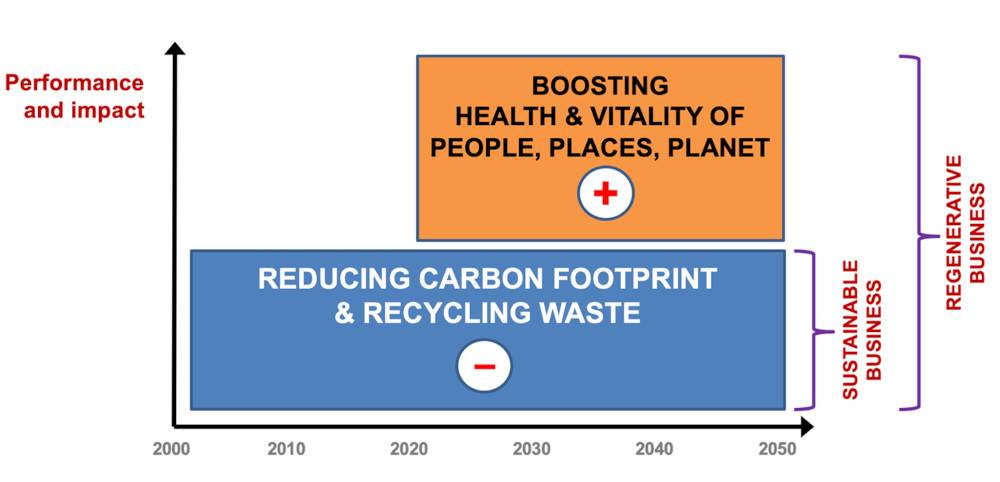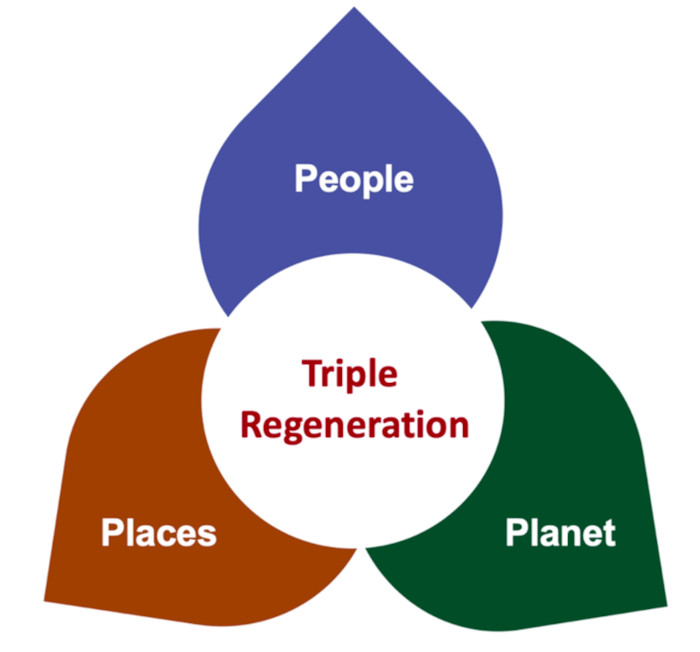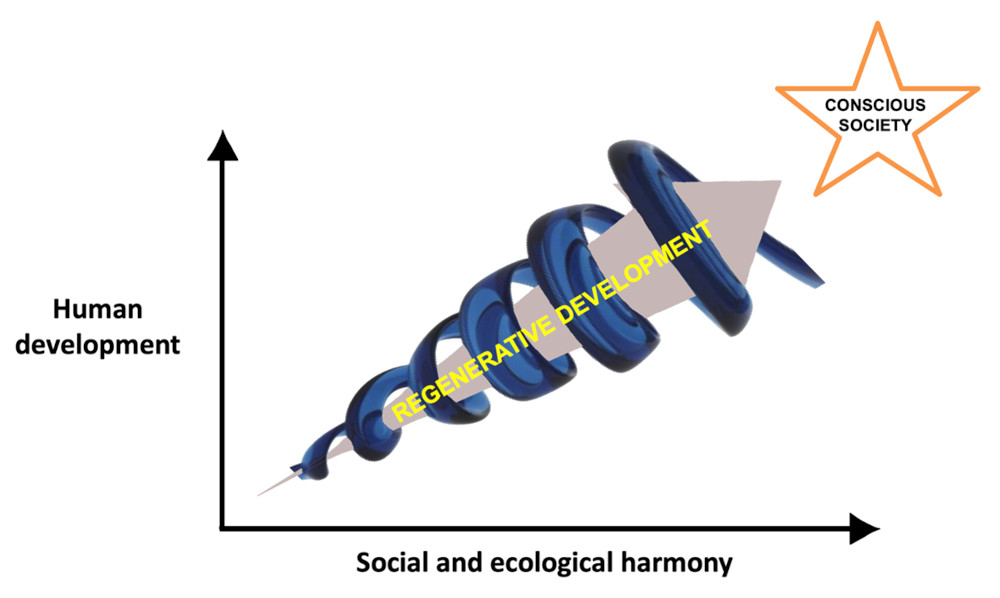Two surveys conducted by ReGenFriends in 2019
and again in 2020 showed that almost 80 percent of US
consumers
prefer “regenerative” brands to “sustainable” brands. Co-founder Nils-Michael
Langenborg told
me why: “Aware of the climate emergency, buyers — especially young people — want
companies to go well beyond sustainability. They find the term sustainable too
passive. They demand that businesses take inspiration from
nature and build a
virtuous, regenerative
economy
based on renewal, restoration and growth (the three essential
qualities of all living
systems).”
Businesses need to take inspiration from nature in order to transition to a
regenerative
model.
In her uplifting TED talk, “How trees communicate with each
other,”
Suzanne Simard — a
forest ecology professor at the University of British Columbia — reveals how
nature is altruistic, a trait not associated with the cutthroat corporate
environment. Forest trees generously exchange information and
nutrients
through an extensive network of soil fungi.
Imagine if businesses reinvented their value chains and business models to
function in a selfless manner similar to a forest. They will then operate as
regenerative
businesses
that contribute 10x and even 100x more to society and the planet than they
consume. To borrow organizational psychologist Adam Grant’s analogy,
businesses can evolve from “takers” to
“givers.”
A sustainable business aims to minimize its ecological footprint. On the other
hand, a regenerative business consciously strives to expand expand its
socio-ecological
handprint
by enhancing the wellbeing and sustainability of communities and the
environment, as described by
Gregory Norris, director of
SHINE — a joint MIT/Harvard project. By doing
this, regenerative businesses can attain better financial results and influence
compared to their peers focused on sustainability.
Regeneration is
still a developing paradigm. Currently, there is no universally accepted
definition for what regeneration truly entails. Therefore, regeneration today is
polysemic (it continues to have multiple meanings as a concept),
polymorphous (it is applied in various ways in practice), and polyvalent (it
produces varied results in term of impact).
Rather than waste time defining what regeneration is, we should explain what
it does. This is vital in our capitalist system which — due to its
reductionist thinking and profit motive — tends to hijack and essentialize
broad concepts and apply them in a selective, narrow and superficial fashion to
achieve maximum financial gain.
For instance, the circular
economy paradigm
exhorts companies — in principle — to reduce (production and consumption),
reuse (resources), and recycle (waste). Yet, in reality, most so-called
“circular businesses” mainly concentrate on recycling
waste
to create new products and increase sales — rather than encourage customers to
reduce consumption and reuse existing
products
by, for instance, sharing
them.
To make it worse, most academic case studies and mainstream media articles keep
conflating “circular” with
“recycling”
— further diluting the huge potential and broader
impact
of a circular economy.
If we want the fledging regenerative economy paradigm to not incur the same
stunted fate as the circular economy, we must showcase the breakthrough best
practices
of pioneering firms and communities worldwide that apply regeneration in the
broadest sense to create a wider and deeper social, economic and
ecological impact.
In the past ten years, I researched and interviewed dozens of vanguard
businesses and cities worldwide that are practicing regeneration in a
comprehensive and deeply meaningful way. By studying these pioneering
initiatives, I gleaned three “must-do” insights on how to practice regeneration
intentionally to maximize positive impact on people, places and the planet.
Regeneration must complement and augment sustainability
Regeneration is by no means superior to sustainability. Sustainability and
regeneration are not two rival concepts. Rather, they complement and mutually
reinforce each other. Sustainability and regeneration are synergistic and
symbiotic.
 A regenerative business increases its socio-ecological handprint while
reducing its ecological footprint | Image credit: Navi Radjou
A regenerative business increases its socio-ecological handprint while
reducing its ecological footprint | Image credit: Navi Radjou
In the graphic above, the stacking of the Plus above Minus does not denote a
hierarchy.
Indeed, a regenerative business does better with less: It revitalizes and grows
people, places and the planet (Plus); while also enabling sustainability by
curbing emissions and waste, and reusing and recycling scarce resources (Minus). By
doing this, regenerative
companies
could achieve higher financial success and greater impact compared to their
peers focused solely on sustainability.
Take, Natura — a world-leading, Brazilian
cosmetics brand and sustainability pioneer. Since 2007, Natura has been 100
percent carbon
neutral,
by both reducing and offsetting emissions. By 2023, it had reached 86 percent
circularity in its
packaging
and 95 percent biodegradability in its products, and it aims to achieve net-zero
emissions by 2030. As part of its Commitment to
Life
strategy, Natura aims to not only fight climate change by becoming net-zero but
also protect the Amazon and regenerate its indigenous communities and natural
ecosystems.
Here is an example of how Natura is conserving and regenerating the Amazon’s
ecological and socio-cultural
biodiversity.
The indigenous tribes used to cut down a palm tree called murumuru that
grows in the Amazon and used its wood to make commodity goods such as brooms.
Apparently, we can obtain a highly moisturizing butter from the seeds of this
palm tree that effectively repairs and rejuvenates damaged hair — so, the value
of these seeds is seven times
greater
than that of the wood from this palm tree. Therefore, it would be seven times
more advantageous for the Amazon Indians to keep this remarkable palm tree alive
instead of chopping it down!
So, Natura began collaborating with the tribes to incorporate their traditional
farming methods in order to ethically harvest murumuru butter for use in a
variety of hair care products. Through this mutually beneficial partnership,
Natura is regenerating indigenous communities financially (by increasing their
income opportunities), culturally (by honoring and utilizing their ancestral
agricultural
practices)
and environmentally (by safeguarding the biodiversity of the Amazon and its
rainforests — the historic land of indigenous populations and the world’s
largest carbon
sink).
Regeneration must enhance people and places, as well as the planet
I would like to clarify my emphasis on the human aspect of regeneration. I view
myself as a humanist before being an ecologist. I worry that in today’s
fast-paced, hyper-connected world, our overburdened nervous system may collapse
well before our overextended ecological or social systems.
As Korean-German philosopher Byung-Chul
Han pointed out, we currently
live in “the burnout society.” As
such, before we end the plundering of our scarce natural resources, we need to
stop over-exploiting our mind, body and psyche to death. In addition to
reducing the wealth
gap
between the affluent and the less fortunate, we need to start closing the
internal gap between our desire-driven ego and our estranged soul.
In my upcoming book, The Frugal
Economy,
I humanize the field of economics and show how nascent paradigms such as the
regenerative economy can truly contribute to “mass
flourishing”
— a term coined by Edmund Phelps, winner of the
Nobel Prize for Economics.
Most people, however, don’t live in isolation. They work, interact and reside in
a physical place. Regrettably, in dualistic Western societies, we not only
perceive humans as separate from nature — we also see ourselves as different
from the physical environment where we dwell. We need to redeem the role of
places
in our society and become fully conscious of where we live. We must enact
place-based
and place-sensitive economic-development
strategies
to regenerate the left-behind cities that have struggled to adjust to
globalization in the 1990s and the tech revolution since 2000.
Consequently, we need to expand the concept and implementation of regeneration
beyond just the ecological aspect and also include people and place. I refer to
it as triple regeneration — a holistic approach to boosting the wellbeing of
people, places and the
planet
synergistically.
 Triple regeneration is a holistic approach to revitalize people, places, and
the planet synergistically| Image credit: Navi Radjou
Triple regeneration is a holistic approach to revitalize people, places, and
the planet synergistically| Image credit: Navi Radjou
I invite you to read my inspiring case
study in
Stanford Social Innovation Review to learn how left-behind places in the US
and Europe can adopt a triple regeneration strategy to renew, restore and
grow their people, places and the planet synergistically.
Regeneration must fuel healthy growth for all
Today, there is a raging debate between hard-core ecologists who advocate
degrowth and die-hard
capitalists rooting for
hypergrowth.
Sadly, both are deleterious concepts. In The Song of the
Cell,
Pulitzer-winning physician and biologist Siddhartha
Mukherjee explains that the trillions of
cells in our body eschew both hypergrowth — which, if left uncontrolled, would
catalyze lethal
cancer
— and degrowth, which would result in our physical and mental decline and lead
to death. Rather, our wise cells use discernment and grow selectively to
maintain our optimal health.
We all agree that the current growth model is failing because it heavily
pollutes and exhausts natural resources, leading to climate change; and leaves
people out, aggravating social inequalities. We should, however, be careful to
not throw the “growth baby” out with the bath water. Rather than debate on how
to increase or decrease the quantity of economic growth — as proponents of
hypergrowth and degrowth do — we must vie to improve the quality of
growth,
as our cells wisely do, for all.
We need to adopt Nobel Prize-winning economist Amartya
Sen’s
“capability approach” to unlock the potential of
all individuals and communities in our society. This will empower them to
contribute to and benefit from a new kind of economic development that maximizes
the potential and wellbeing of everyone while respecting our planetary
boundaries.
Specifically, we need to implement a regenerative
development
model that fosters human development, enhances social and ecological harmony,
and guides us towards a conscious
society. By partaking in — and
intentionally shaping — this positive growth cycle, businesses could fulfill a
noble purpose that goes beyond just making profit.
 Regenerative development balances economic activities with human development
and social and ecological harmony, leading us to a conscious society | Image
credit: Navi Radjou
Regenerative development balances economic activities with human development
and social and ecological harmony, leading us to a conscious society | Image
credit: Navi Radjou
The left-behind places in the US and Europe failed to capitalize on the
hypergrowth fueled by new technologies and globalization over the past three
decades. These disadvantaged communities can embrace place-based, regenerative
development
as a generational opportunity to restore, renew and grow their devitalized
people and enhance local natural ecosystems.
Reimagine Appalachia (RI) is a
cross-disciplinary coalition of policy experts, community leaders and labor
organizations from Kentucky, Ohio, Pennsylvania and West
Virginia who have created a plan for the regenerative development of the
region. As RI
notes:
“(For centuries), the Ohio River Valley of the Appalachian region has fueled
the prosperity of other regions while we have suffered. Many of our communities
rank in the bottom 10 percent nationally for their high unemployment and poverty
rates and low incomes.”
To reverse this trend, RI is drawing in both public and private
investments
for regenerative development projects — which will retrain fossil fuel workers
for clean energy and green manufacturing
jobs
and facilitate an equitable transition in Appalachia.
These environmentally friendly, job-creating
projects
aim to repair harmed lands and
waters,
upgrade the power
grid
and boost its local
ownership,
expand decentralized clean energy
production,
boost clean
manufacturing
(ex: electric vehicle and ‘green
locomotive’
production), create a sustainable transportation system, revive wetlands,
support regenerative
farming
and eco-tourism that will employ minorities, and capture carbon emissions with
natural environments.
Amanda Woodrum,
co-director of RI, told me that RI’s regenerative objective is to heal and
restore the people and the
land
in Appalachia, revive its economy, and create enduring local
prosperity by innovatively
utilizing the region’s existing natural, physical and human resources.
To effectively address the triple urgency of our era — the collapse of the human
psyche, exploding social inequalities and worsening climate change — businesses
can’t just focus on sustainability. They must evolve into regenerative
businesses that positively impact society and Earth. By boosting the health and
vitality of people, places and the planet synergistically, companies can
catalyze regenerative development that includes and benefits everyone.
Read more about the frugal economy:
This article has been partially adapted from the author’s upcoming book, The
Frugal Economy: A Guide to Building a Better World with
Less,
published by Wiley and Thinkers50.
Get the latest insights, trends, and innovations to help position yourself at the forefront of sustainable business leadership—delivered straight to your inbox.
Navi Radjou is a French-American scholar and advisor on innovation and leadership.
Published Oct 10, 2024 8am EDT / 5am PDT / 1pm BST / 2pm CEST